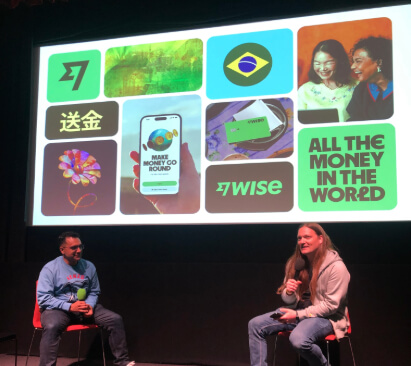Careers in Design
Make global money simple and human for people without borders.
You’ll be helping to drive the design strategy and direction shaping current and future work.

Global money made simple
In the Design team at Wise, you’ll help us to understand people, ask the right questions, and make abstract ideas tangible.
You’ll focus on outcome, not output, and aim for solutions, not quick-fix hacks — keeping humans at the centre of the work. You’ll be trusted to do the right thing and you’re given plenty of opportunity to grow. You’ll ask “why?” before you ask “how?”. Just because we can build it, it doesn’t make it useful.
So, what are we focused on?

1
PRODUCT DESIGN
Work with product teams to untangle complex customer problems. Explore, test and deliver useful, usable and delightful ways to manage global money.

2
BRAND AND CREATIVE DESIGN
Our brand and creative designers work across multiple teams to educate, inform and create memorable moments, delivering business focussed, creative led experiences that customers love.

3
COPY
Help teams write clear, delightful, and effective copy — so customers understand Wise better, trust us sooner, and solve their problems faster.

4
RESEARCH
Build empathy for our customers, so that we can build a better product.

Jobs you might be interested in
Salary
-
Location
London
Team
Design
Locations
London
Description
Here’s how you’ll be contributingCollaborating with your Product and Engineering partners to lead the Squad, set the vision, define strategy and coach the teams to deliver itYou’ll be lead for all the
Reference
5655d406-b076-4f6b-83b2-2f40e2c9f2c2
Expiry Date
01/01/0001
Salary
£90,000 - £110,000
Location
London
Team
Design
Locations
London
Description
We’re looking for a Staff Product Designer to join and collaborate with our teams in the FinCrime Squad.As a Staff Product Designer you will lead projects and multiple teams across complex product are
Reference
be8163d7-0985-4ee3-a257-4bf456bd2b00
Expiry Date
01/01/0001
Salary
£65,000 - £90,000
Location
London
Team
Design
Locations
London
Description
At Wise, we have a clear mission — money without borders. Built by and for people who live global lives. We’re at a genuinely exciting time when building more transparent and convenient ways to pay an
Reference
0d75f89b-5fb1-406a-a1a6-b72697ed8a96
Expiry Date
01/01/0001
Salary
£65,000 - £90,000
Location
London
Team
Design
Locations
London
Description
Your mission: We’re looking for a talented, visually strong Senior Product Designer to join our Send teams in London. You’ll join a team that is core to Wise and central in helping millions of people
Reference
9f8c400a-cc9a-4a0f-9896-aa080126be76
Expiry Date
01/01/0001
Related blogs
